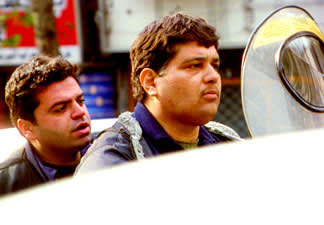Crimson Gold begins with a climax, then retreats in time and meanders through the lives of its two protagonists for clarity. Hussein and Ali are Iranian urbanites disaffected by the ill-fitting visitation of Western capitalism. Ali is by far the most adapted. Blessed by slight good looks, he feels unaware but equipped to roll with the punches. He is sort of a Sancho Panches to Hussein, who is affianced to marry Ali's sister, and an anti-Don Quixote. A hulking presence, his face oddly swollen from cortisone injections to treat a wound or condition dating back to his days fighting in the army, he is an impassive monolith, a depressive, a non-participant. Gold jewellery, a traditional means of security and a symbol of success in the new order, defines the cultural context. Pizza deliverers and petty thieves, Hussein and Ali look from the outside in. The frequent presence of the police in the culture is casually accepted. In one scene, Hussein is prevented by them from making a delivery to a sealed off building. He cools his heels as the police refuse to answer his questions. Giving up, he offers the pizza around to the police and all the waiting characters, especially an adolescent guard who will not partake until he sees his superior do so. Hussein does not appear to derive pleasure or satisfaction from his gestures. It is this emotional absence that makes Crimson Gold both intriguing and difficult to read. Evidently low budget, the objective camera work has, at times, an iconic force that makes one aware of what an over-inflation of style we live in daily. There is force in this simplicity and despair at its disappearance. However, without patience and curiosity, the austere inclinations of this film will not yield easily. (Mongrel Media)
Crimson Gold
Jafar Panahi

BY Elizabeth BaileyPublished May 1, 2004